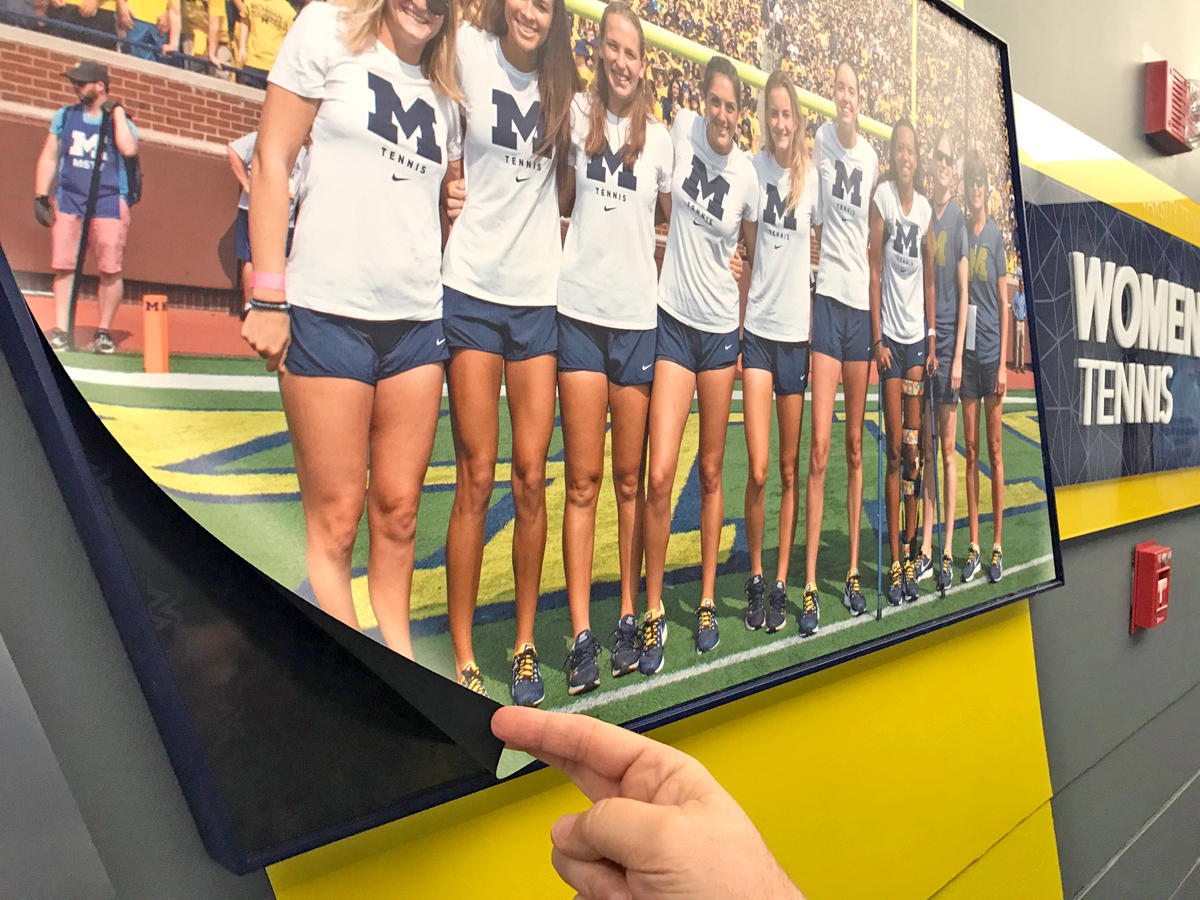Design
Law of Attraction
Affordability and flexibility are the forces pulling magnetic media.
Published
6 years agoon

It’s no mystery why magnetic signage is seemingly ubiquitous. Not to oversimplify the process, but it’s simple. Changing the message? Simple. Installation? Production? The right equipment? Selling magnetic signs to customers? Yes, those can be simple as well.
Today, sign companies specialize in large, wide-format graphics that utilize magnetic-receptive media and relish the fact that the image can be changed out with little or no difficulty. These two sign companies do just that and both – regardless of size – enjoy the thriving magnetic signage market.
SERVING AN ACE
At the Univ. of Michigan’s (Ann Arbor, MI) Varsity Tennis Center, the Wolverines’ men’s and women’s teams are the chief attraction. However, what adds pizzazz by presenting the current lineup and history of the storied tennis program is magnetic signage created by Shaw PPC Design (Novi, MI). While the company has been designing and manufacturing custom signage and fixtures since 1932, it has been offering magnetic signage for just over 10 years, company president Tom Smith said.
The Tennis Center project was not unusual for Shaw, which is situated some 30 miles from Motor City. According to Project Manager Don Schroeder, “We do a ton of this work for many other colleges and retailers.” A one-stop shop, all the design and printing of magnetic signage take place in-house.
And what makes such projects so successful is the versatility of the graphics. “You cannot tell when it’s on the wall that it’s a magnetic sign,” Smith said. In addition, “Installation is expensive, so it’s cost effective [having the customer handle the installation] and they can have students change them out.” Not only are the images in the Tennis Center a great attraction, Shaw also has schedule boards scattered throughout the Ann Arbor campus that can be swapped out by students.
There are two options when dealing with magnetics: magnetic media and magnetic-receptive media. Magnetic media directly receives the ink and is magnetized. Magnetic-receptive media is part of an overall display system. Traditionally a magnetic “base” is installed. Then the magnetic-receptive graphics are printed and adhered to the installed magnetic backing.
AdvertisementShaw PPC Design utilizes Flexiron, a magnetic-receptive material that adheres to all types of low-profile magnets, including flexible magnetic sheeting and strip, plus ceramic and neodymium (rigid) magnets. Both sides (front and back) of Flexiron attract magnets. According to Smith and Schroeder, Flexiron is easy to drill or cut with a knife, a die-cutter, a cutting plotter or scissors. The sharp graphics are achieved via large-format Durst printers, which print 126 in. wide, roll-to-roll and/or 98 in. wide, direct-to substrate – and are used on jobs like the Tennis Center that call for either rigid or roll-to-roll magnetic-receptive media.
ADHERING TO THE RULES

Large or small, franchise or independent, market opportunities for sign and display makers are limitless with printable-magnetic and magnetic-receptive materials. Vehicle signs, menu boards, directories, calendars and refrigerator magnets are all part and parcel of FASTSIGNS of Blue Ash’s (Blue Ash, OH) selection of services.
According to owner Mike Langdon, vehicle magnetic signs can be used on a car, truck, bus or van, acting as a company’s mobile business card. It hardly takes a mathematician to imagine the number of impressions a vehicle sign can garner. Traditionally mounted on both of the vehicle’s front doors, the range of designs differs as widely as the businesses they tout. Given the advancements in printable magnetics, the graphics can include images and designs heretofore not possible.
As Langdon suggested, “Vehicle magnetics are a fairly low-cost way to identify your vehicle and advertise. They can be applied and taken off when you don’t want the vehicle identified, such as going out for an evening.” He added that the magnetic may be applied periodically when the vehicle needs identification as when going through a security gate. “They are also very good for quick fleet identification and are fairly simple,” Langdon said, “so the turn time is a day or two on a typical pair of magnetics.”
Magnetic vehicle signs can also be a source of issues. For example, if the magnet is not securely attached, wind can peel the sign from the vehicle, particularly on the high-way. One helpful remedy and one of the final steps prior to installation, is to round off the corners. Pointed or dog-eared corners can serve as a sail to lift the sign from the vehicle.
AdvertisementMagnetic signs also require maintenance and moisture prevention. If dirt and condensation build up between the surfaces, the sign will lose its ability to adhere, so vehicle signs need to be kept dry and clean. Conversely, moisture build-up between the magnet and vehicle can also create too powerful a bond, making removal difficult. Finally, magnets will not stick to non-ferrous metals and alloys including aluminum, fiberglass, plastics or any type of auto body repair fillers. (Many late-model vehicle bodies are not metal.) Those caveats aside, magnetic vehicle signs have a low initial cost, high-read rate and can even provide the customer the opportunity to design their own sign.
Fastsigns of Blue Ash, for example, does not necessarily design from concept to completion. They allow the customer to supply much of the artwork. Not surprisingly, that can be challenging. “Logos from customers arrive in various forms from low-resolution JPGs to good outlined files,” Langdon said. “If the image is fairly easy, we go ahead and recreate the art.” That recreation will traditionally be done utilizing Illustrator as well as Gerber Composer. In addition, when a logo recreation is labor-intensive, they charge design fees.
CURRENT PRACTICES
Most signshops use 30-mil., matte white magnetic media trimmed to size. In addition, most magnetic media commonly used for vehicle signage is magnetized with at least with 12 poles per in. (ppi). The thicker the sheet – the higher the ppi – the more pull a magnet possesses, and, flexible magnetic sheeting has less magnetic pull than rigid magnets. Today’s printers, however, can print on almost any magnetic media.
Langdon’s finished products are created using an HP Latex printer. If lamination is needed, he will utilize SEAL and GBC print finishing solutions. “Primarily we use Magnum Magnetics [Marietta, OH]. On occasion, we use MSI ProMag [Boyne City, MI] for better pole strength than most others.”
The customer care of magnetic vehicle signs is fairly straightforward. Langdon’s advice to customers is that magnetics should be taken off weekly, cleaned and dried (both car and signage). “If waxing the vehicle,” Langdon suggested, “use the same wax on the back of the magnetic.” When the sign is not in use it should be stored flat. “The side of a refrigerator or steel cabinet works well,” he said.
With each sale, Langdon offers the following advice: “All vehicle paint finishes are not the same. Recent new finishes, especially noted on Chrysler vehicles, could have an adverse reaction to the magnetic material. This especially holds true on darker vehicles.” He recommends customers closely keep watch on their vehicle/magnetic relationship with weekly removal and cleaning of both surfaces. “By signing this invoice, you agree to hold us harm-less of any damages that may develop on the surface of any vehicle that these magnetics may be used on,” reads the conclusion of Langdon’s sales agreement. Attractive advice.
AdvertisementMagnets and magnetic-receptive media are now common-place primarily because of their low cost, ease of use and production. They empower the end user and are such an efficient, attractive method of advertising that it’s difficult to make it through a day without encountering magnetic signage. Magnetic media is becoming a bigger part of large signshops’ production schedules and the bread and butter for many smaller and franchised signshops.
Clearly magnetic signs are not polarizing end users; most, in fact, are drawn to them. Given the technological trajectory that signmaking tools are on, the application of magnetics is becoming increasingly attractive. Sign companies would be wise to remain a force in the magnetics market.

SPONSORED VIDEO
Introducing the Sign Industry Podcast
The Sign Industry Podcast is a platform for every sign person out there — from the old-timers who bent neon and hand-lettered boats to those venturing into new technologies — we want to get their stories out for everyone to hear. Come join us and listen to stories, learn tricks or techniques, and get insights of what’s to come. We are the world’s second oldest profession. The folks who started the world’s oldest profession needed a sign.
You may like
Advertisement
Subscribe

Magazine
Get the most important news
and business ideas from Signsofthetimes Magazine.
Advertisement
Most Popular
-

 Tip Sheet4 days ago
Tip Sheet4 days agoAlways Brand Yourself and Wear Fewer Hats — Two of April’s Sign Tips
-

 Business Management2 weeks ago
Business Management2 weeks agoWhen Should Sign Companies Hire Salespeople or Fire Customers?
-

 Women in Signs2 weeks ago
Women in Signs2 weeks ago2024 Women in Signs Award Winners Excel in Diverse Roles
-

 Real Deal5 days ago
Real Deal5 days agoA Woman Sign Company Owner Confronts a Sexist Wholesaler
-

 Benchmarks1 day ago
Benchmarks1 day ago6 Sports Venue Signs Deserving a Standing Ovation
-

 Editor's Note1 week ago
Editor's Note1 week agoWhy We Still Need the Women in Signs Award
-

 Line Time2 weeks ago
Line Time2 weeks agoOne Less Thing to Do for Sign Customers
-

 Product Buying + Technology1 week ago
Product Buying + Technology1 week agoADA Signs and More Uses for Engraving Machines









